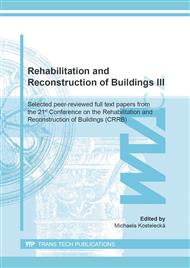p.70
p.79
p.86
p.92
p.98
p.105
p.119
p.127
p.135
Impact of Surface Treatment of Historic Bricks on the Process of Water Vapours Diffusion
Abstract:
The article is dealing with impact of selected types of surface finish of historic bricks on their diffusion properties, i.e. on the process of their spontaneous self-drying. Within the pilot experiment was monitored diffusion flow of water vapours going from humid brick fragment through its surface finish to the surrounding environment. Brick fragment was saturated with water to a degree usually corresponding to common humidity of uninsulated underground brickwork of historic buildings. Surrounding environment had parameters of common heated object for residential or administrative purpose or an object for storage of things sensitive to impact of high relative air humidity. Test results proved that any surface finish of the brickwork, even its hydropohobisation is significantly slowing down process of drying of the masonry compared to the speed of drying of the untreated brickwork. It is evident from the course of lines of diffusion flows that the process of water vapours diffusion is most intense at the beginning of the period (about 5 to 10 days) and after this period the diffusion flow speed goes to a long-term stabilisation of diffusion flow speed, in such a way that its course is in average corresponding to linear functional dependence on time. In conclusion of the article we introduce on practical example calculation of real time of drying up of the masonry in historic building selected space flooded with flood water where is now running process of natural drying without additional humidity sources.
Info:
Periodical:
Pages:
98-104
Citation:
Online since:
October 2020
Authors:
Keywords:
Price:
Сopyright:
© 2020 Trans Tech Publications Ltd. All Rights Reserved
Share:
Citation:


